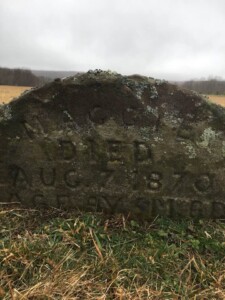“We’ll Walk in Together”
 Sunday routine together
Sunday routine together
Every Sunday when John Brenneman drove the horse and buggy home from church, he pulled on the reins to guide the horse into their lane. That wasn’t really necessary because the horse knew this was home, but John did it out of habit. The horse pulled the buggy up to the house, where John gave a slight tug on the reins, and the horse stopped. That was the signal for Lydia and the six children to get off the buggy. Mama carried Louis while the other children ran into the house as John proceeded to the barn. There he unhitched the buggy, fed, watered the horse, and put him in his stall.
When that was finished, John walked to the house. He knew dinner would be served soon and it would be good. Every Sunday, this is the way they did it. Lydia and the children walked into the house and John took the horse and buggy to the barn, until 1870, when diphtheria hit the community hard.
Winter and diphtheria* arrive together
Cold winter winds and snow did not keep diphtheria from spreading through families and the community. As February temperatures dropped, the squeeze of death was felt as John and Lydia did the best they could for their children who lay sick with the disease.
When Wednesday of that week arrived, their six-year-old Catherine (Katie) was sicker than the others. Would she be the first to lose the battle? She was. It was February 16. They buried Katie in a small cemetery on the home farm in western Maryland. Together, they returned to their home to care for the remaining children.
Hardly was Katie’s grave covered when the first day of the week peered into the horizon. It was February 20 when ten-year-old Anna died. One day later, the death of little Louis, almost two, diminished their family by half. Once again, John and Lydia made that trip to the graveyard on their farm, where two more graves were dug for burial.
More Loss
On March 3, only ten days later, the grief-stricken parents said goodbye to Elizabeth, who was almost twelve. Another grave dug, and another trip to the graveyard on the farm. Their sorrow was real and very present in the daily after-math of burying four children within two weeks. The little mounds of dirt in the graveyard were a constant reminder of what they had lost, not to mention the memories and unfinished dreams that lay in their minds.
 John and Lydia continued to care for the two remaining children. Perhaps, they thought, these two would be spared, but this was not to be. Almost four months later on the fourth of July, four-year-old Savilla died. Now the family was left with only one child.
John and Lydia continued to care for the two remaining children. Perhaps, they thought, these two would be spared, but this was not to be. Almost four months later on the fourth of July, four-year-old Savilla died. Now the family was left with only one child.
Merely one month later, as if to defeat John and Lydia’s faith, diphtheria stole their last child. It was August 7, and Magdelina was nine.
Six children and six graves in six months. Six trips to the graveyard on the family farm.
Faith in loss
As with other contagious diseases, John and Lydia had to be quarantined. For how long, we don’t know. Certainly they missed the support of their church people who could not visit in their home during these weeks.
On the first Sunday they went to church, John hitched the horse to the buggy. He and Lydia rode to church alone, but together. Who knows what the minister shared that morning to the congregation on that day in 1870? Other families had buried children also, but none were childless after burying every one of their children; none, that is, but Lydia and John.
Yes, their grief was raw and real. But they went. Being with other families was painful, but some of them were grieving, too. This was where they would find comfort and care. John and Lydia still went to church. They sorrowed, but they had hope, and that is why they could go to church.
That Sunday after the service was over, John brought the horse to Lydia, where she stepped up into the buggy. Her step wasn’t as spry as it used to be, for she was grieving. Things were going to be different now. How would they bear their loss?!
At home – and together
Did they talk together on the way home, or was there silence as the horse trotted toward home? Was there conversation about the words the minister shared that morning, or was each lost in memories and contemplation?
Nearing the lane, John pulled on the reins to guide the horse up to the house. He halted the horse at the walk where the children and Lydia used to climb down from the buggy.
But Lydia didn’t get out of the buggy. She just sat there. John waited.
Then Lydia said, “I don’t think I can walk in there alone.”
And John replied, “You don’t need to. I’ll take care of the horse later. We will walk in together.”
Together, John and Lydia stepped down from the buggy. Hands clasped, they walked into the house, together. They were still bereft, but they still had faith. They would walk this path, together.

*Diphtheria is a serious bacterial infection that caused the death of many children and adults before vaccines were developed.
Author’s note
Nine months after the death of their sixth child, John and Lydia welcomed a son. It was May 7, 1871, and they called him Noah. Noah was one week old when John and Lydia took into their home a seven-year-old boy, Henry Musser.
Noah married Barbara Orendorf and was ordained as a minister. Although they never had children of their own, they became “houseparents” of the Children’s Home in western Maryland. The home was begun in 1913 in their home in Accident, Maryland, and later moved to Grantsville, Maryland, where Noah served as superintendent. Noah became known and loved by many children who called him Papa Brenneman. The former home is now the site of Goodwill Retirement Community.
Acknowledgements
Special thanks to Carol Guntz Maust, who lives on the farm of the Brenneman cemetery and took the photos for this post.
Credit for the photo of the horse and buggy belongs to Julia Tice.
Information of this true story was passed down for generations in my community. I heard this story many times as a child. It was told by family members, by community folks, and sometimes used in sermon illustrations in church. Verification of actual dates comes from The Daniel Beachy Family of Aurora, West Virginia, by M. Marie and Paul H. Yoder, Masthof Press, Morgantown PA, 1975, pp. 163-165.
Another note:
I failed to reckon with the fact that a quarantine was in place following the deaths of the children. Therefore we don’t know for certain when the first Sunday was that the John and Lydia could go back to church. I have changed the story accordingly.









Thank you. I never heard this before.
This shows me how strong Faith can be when your partner with standing with you, just like Lose they had a good reason to give up but pushed on cause they knew God would not let them down



I never heard this thanks for sharing
And thanks for reading it and letting me know!
thanks for the article,it brings back many memories. the noah brenneman house was right at the bottom of the hill,the entrance to Goodwill home. our house was on the other side of the hill from the nursing home. We used to drive our young cattle to pasture every spring in the Bittlnger area,and I remember that there was a Brenneman farm in the area,I think it might be that farm. p. s . we took our cattle to the Mahlon Bender farm
As we fight the deadly rotavirus let us pray we do not have a repeat. Catherine bowles catheroine